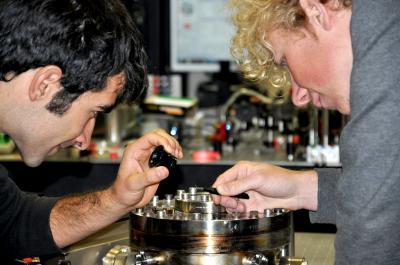Laser physicists have found a way to make atomic-force microscope probes 20 times more sensitive, using laser beams to cool a nanowire probe to minus 265 degrees Celsius.
Atomic force microscopes achieve extraordinarily sensitivity measurements of microscopic features by scanning a wire probe over a surface.
The technique makes it capable of detecting forces as small as the weight of an individual virus.
The development could be used to improve the resolution of atomic-force microscopes, which are the state-of-the-art tool for measuring nanoscopic structures and the tiny forces between molecules.
"The level of sensitivity achieved after cooling is accurate enough for us to sense the weight of a large virus that is 100 billion times lighter than a mosquito," said Dr. Ben Buchler from the
Australian National University
Research School of Physics and Engineering.

Giovanni Guccione (left) and Harry Slatyer examine their gold coated nanowire probe in the Quantum Optics Laboratory at the Australian National University. Credit: ANU Quantum Optics Group
However, the probes, around 500 times finer than a human hair, are prone to vibration.
"At room temperature the probe vibrates, just because it is warm, and this can make your measurements noisy," said coauthor Professor Ping Koy Lam. "We can stop this motion by shining lasers at the probe."
The force sensor used by the team was a 200 nm-wide silver gallium nanowire coated with gold.
"The laser makes the probe warp and move due to heat. But we have learned to control this warping effect and were able to use the effect to counter the thermal vibration of the probe," said Giovanni Guccione, a Ph.D. student on the team.
However, the probe cannot be used while the laser is on as the laser effect overwhelms the sensitive probe. So the laser has to be turned off and any measurements quickly made before the probe heats up within a few milliseconds. By making measurements over a number of cycles of heating and cooling, an accurate value can be found.
"We now understand this cooling effect really well," says Ph.D. student Harry Slatyer. "With clever data processing we might be able to improve the sensitivity, and even eliminate the need for a cooling laser."
Source: Australian National University






Comments